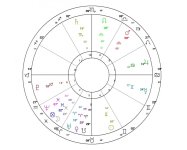Barleywine
I've been working on solar return charts for this year and decided to try them two ways: the usual Tropical non-precessed chart and a Sidereal chart. I'm using James Eshelman's method of analysis, which derives from Cyril Fagan's "foreground/middleground/background" model. This method pays a lot of attention to angularity, a bit less to "hard" aspects (none to "soft"), very little to other house placements and virtually none to sign placements, rulerships or "dispositorships." I've attached an example chart done both ways (note that I didn't post the dual-wheel charts showing SR and natal planets to keep this simple).
The Tropical chart was done with Halloran software and shows Pluto and Jupiter as "immediate foreground," especially Pluto right on the Ascendant. Jupiter is near the Descendant and happens to be in its exaltation. What is shaping up for this year (in reality, that is, I'm not drawing this conclusion from the chart) is likely death of the elderly father and a sizable inheritance; an "event-oriented" view of the chart ignoring psychological "haze" and cleared of the usual house and sign meanings shows the possibility of "something" significant happening. Both Saturn and Venus are (very) marginally foreground, although Saturn is elevated in the 10th, and everything else is either background or middleground. There is a Water Grand Trine with Moon-Jupiter-Saturn and the angular Jupiter-Pluto opposition, both square to background Uranus in the 3rd.
The Sidereal chart was done with Riyal and doesn't show any angularity or even any strongly "foreground" planets. I'm not sure what to make of this chart until I spend some more time with it, but nothing is jumping out at me as significant.
Both of these charts have natal planets in the SR angles (especially the precessed one), but that is the next level of analysis and I'm not quite there yet.
And my question is . . . which of these do YOU see as more likely to indicate important life-events, and why?
The Tropical chart was done with Halloran software and shows Pluto and Jupiter as "immediate foreground," especially Pluto right on the Ascendant. Jupiter is near the Descendant and happens to be in its exaltation. What is shaping up for this year (in reality, that is, I'm not drawing this conclusion from the chart) is likely death of the elderly father and a sizable inheritance; an "event-oriented" view of the chart ignoring psychological "haze" and cleared of the usual house and sign meanings shows the possibility of "something" significant happening. Both Saturn and Venus are (very) marginally foreground, although Saturn is elevated in the 10th, and everything else is either background or middleground. There is a Water Grand Trine with Moon-Jupiter-Saturn and the angular Jupiter-Pluto opposition, both square to background Uranus in the 3rd.
The Sidereal chart was done with Riyal and doesn't show any angularity or even any strongly "foreground" planets. I'm not sure what to make of this chart until I spend some more time with it, but nothing is jumping out at me as significant.
Both of these charts have natal planets in the SR angles (especially the precessed one), but that is the next level of analysis and I'm not quite there yet.
And my question is . . . which of these do YOU see as more likely to indicate important life-events, and why?



